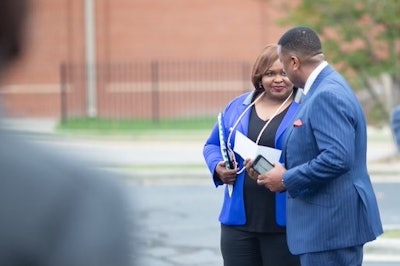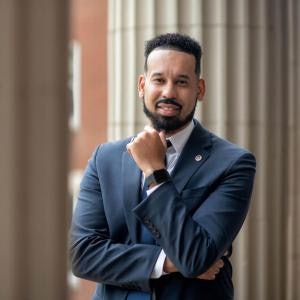For North Carolina Agricultural & Technical (NCA&T) University, the 2017 headlines were the last straw.
NCA&T is an Historically Black institution in Greensboro, N.C. On Oct. 8, 2017, John Cook was murdered at an apartment complex on the west side of the city. Cook had attended NCA&T three years before, and police shared that detail with local reporters. Joy Cook, left, associate vice chancellor for strategic communication and chief communications officer at Fayetteville State University, at work on campus.
Joy Cook, left, associate vice chancellor for strategic communication and chief communications officer at Fayetteville State University, at work on campus.
Although Cook’s murder had nothing to do with NCA&T, the news connected the incident with NCA&T's homecoming, happening coincidentally at the same time. Todd Simmons, associate vice chancellor of university relations at NCA&T, said alumni were so angry he thought they would “burst into flames.”
So, he and his team got to work. Dr. Nicole Pride, NCA&T’s former chief of staff, penned an op-ed addressing the negative narratives being constructed around NCA&T.
“For two solid weeks, that op-ed was in the number one spot of the most-read opinion pieces on the Greensboro News and Record website, because it touched such a nerve with people who had borne the brunt of that unfairness for so many years,” said Simmons. “Now, when anything happens, the media stop, and think, and ask themselves, ‘Does this really have anything to do with NCA&T?’”
By “clearing up the home media environment,” Simmons said, NCA&T was finally able to engage with the news on stories of success and academic research.
Changing an HBCU’s relationship with media is just one aspect of the work done by Simmons and other brand leaders. That work would be made easier with resources that many HBCUs do not have, considering many HBCUs have long been underfunded. However, within the last two years, there has been renewed interest in the work of HBCUs given the nationwide focus on racial justice following the murders of George Floyd, Breonna Taylor, and others coupled with the disproportionate impact of the COVID-19 pandemic on Black communities.
HBCU communications departments hope to attract philanthropists like MacKenzie Scott, who gave $560 million to 23 HBCUs in 2020 and 2021, including a $45 million gift to NCA&T. Experts say that telling an HBCU’s story takes intentional effort, upper-level support, and dedicated and ambitious vision.
Frank Tramble is vice president and chief communications officer at Howard University, an HBCU in D.C. that received $40 million from Scott in 2020. Tramble previously worked in the communications departments at two large Predominately White Institutions (PWIs), Georgetown University and Michigan State University, and he knew he would have a lot of building to do when he arrived at Howard.
“My team at Georgetown University was two to three times larger than Howard’s full team,” said Tramble. “Georgetown has 80 to 90 communicators — I walked into the position [at Howard] with 14 communicators across the hospital, university, and athletics.”
 Frank Tramble, vice president and chief communications officer at Howard University.
Frank Tramble, vice president and chief communications officer at Howard University.
Since its renovation, website visits have tripled. In 2021, Howard Magazine won three Eddie and Ozzie awards, which recognize excellence in the publishing industry. Tramble is about to hire Howard’s first videographer, which will expand storytelling methods.
“Howard is full of stories waiting to be told,” said Tramble. “These stories aren’t about welfare, it’s about understanding the perseverance and character it takes to overcome every obstacle in the world and then find success, how Howard helps that person push through that process.”
Social media is indeed a viable marketing tool. Joy Cook, associate vice chancellor for strategic communication and chief communications officer at Fayetteville State University (FSU), an HBCU in Fayetteville, N.C., hired a social media manager and created a strategic plan for best practices in social media marketing. By Cook’s count, the total reach of all FSU social media handles is 364 million individuals a month.
“We joined TikTok, we got verified on Facebook. We increased our engagement on Twitter and live-tweeted different things that were going on around campus,” said Cook. “On Instagram, our social media manager uses a proactive approach and engages with reels, stories, anything our students or potential students or alumni might see.”
Cook, Tramble, and Simmons all agree that they are able to shape narratives and perceptions of their school thanks to the support of their institutional leaders.
“Chancellor [Darrell T. Allison] has an amazing vision and is a thought leader that believes in innovation and bringing things to the 21st century,” said Cook, adding that Allison "understands that expanding our footprint through communication, marketing, and social media strategy, expands the opportunities for people to find out about the gem that FSU is — and it really is.”
Liann Herder can be reached at [email protected].




















